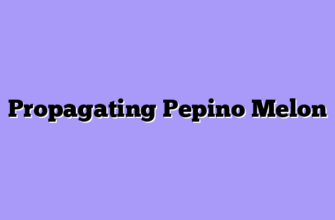The Pepino Melon: Nature’s Sweet Surprise
Before we jump into the uses, let me paint you a picture of this peculiar fruit. Imagine a melon and a cucumber had a love child – that’s essentially what a pepino melon is. It’s got the shape of a small melon, the smooth skin of a cucumber, and a flavor that’s somewhere between a honeydew and a pear. Intriguing, right?
I remember the first time I bit into a ripe pepino melon. It was like a flavor explosion in my mouth! The sweetness hit me first, followed by a refreshing coolness that reminded me of cucumber. And let me tell you, that moment changed my life as a farmer. I knew I had to grow these little wonders and share them with the world.
Now, you might be wondering, “Ann, what’s so special about this fruit?” Well, let me tell you, pepino melons are not just a pretty face in the fruit bowl. They’re packed with vitamins A and C, low in calories, and have a good amount of fiber. It’s like nature’s way of saying, “Here’s a treat that’s good for you too!”
But the real magic of pepino melons lies in their versatility. These little guys are culinary chameleons, adapting to whatever role you give them in the kitchen. From sweet to savory, from breakfast to dinner, pepino melons are always ready to shine. Are you ready to explore the possibilities? Let’s go!
Fresh and Fabulous: Eating Pepino Melons Raw
The simplest way to enjoy a pepino melon is just as nature intended – raw and fresh. When perfectly ripe, these fruits are a delight to eat out of hand. Just slice them in half, scoop out the seeds (if you want – they’re edible too!), and dig in. It’s nature’s fast food, if you ask me!

Here’s a pro tip: try sprinkling a little salt on your pepino melon slices. I know it sounds weird, but trust me on this one. The salt enhances the sweetness and brings out the melon’s complex flavors. It’s a trick I learned from my grandmother, and it’s never failed to impress at farmers’ markets.
And let’s not forget about smoothies! Pepino melons blend beautifully with other fruits. My favorite combination is pepino melon, pineapple, and a handful of mint. It’s refreshing, unique, and packed with nutrients. Plus, it’s a great way to use up those slightly overripe melons that are too soft for slicing.
Cooking with Pepino Melons: A Culinary Adventure
Now, here’s where things get really exciting. Pepino melons aren’t just for eating raw – they’re surprisingly versatile in cooking too. Their mild flavor and firm texture make them perfect for both sweet and savory dishes.
- Let’s start with the sweet stuff. Pepino melons make an excellent base for sorbets and ice creams. Their high water content gives a lovely, refreshing texture to frozen desserts. I once made a pepino melon and lime sorbet that was the hit of our summer farm-to-table dinner. It was like a cool breeze on a hot day, absolutely divine!
- But wait, there’s more! Have you ever thought about grilling fruit? Well, pepino melons are perfect candidates for the grill. A quick sear caramelizes their natural sugars, intensifying the sweetness and adding a subtle smoky flavor. Serve them with a scoop of vanilla ice cream, and you’ve got a dessert that’ll make your taste buds do a happy dance.
- Now, let’s venture into savory territory. Pepino melons can be a fantastic addition to salsas and chutneys. Their mild flavor provides a great backdrop for spicier ingredients like chili peppers or ginger. I love to make a pepino melon salsa with red onion, cilantro, and a squeeze of lime. It’s perfect with grilled fish or chicken, adding a fresh, tropical twist to any meal.
And here’s a little secret from my kitchen: pepino melons make an amazing addition to gazpacho. Their cucumber-like freshness blends beautifully with tomatoes and peppers, creating a soup that’s both familiar and intriguingly different. It’s become my go-to recipe for using up excess pepino melons at the end of the season.
Beyond the Kitchen: Other Uses of Pepino Melons
Believe it or not, the uses of pepino melons extend beyond the culinary world. These versatile fruits have found their way into skincare routines and even traditional medicine in some cultures. Now, I’m no doctor or beauty expert, but I can share what I’ve learned from years of working with these fascinating fruits.
In skincare, pepino melons are prized for their high water content and vitamin C. Some folks swear by pepino melon face masks for hydrating and brightening the skin. I’ve tried it myself, mashing up some overripe pepino melons and applying them to my face after a long day in the fields. I can’t say I looked ten years younger, but my skin did feel refreshed and soft!
Traditionally, pepino melons have been used in some parts of South America to aid digestion and reduce inflammation. While I can’t vouch for any medical claims, I can say that the fiber content in these fruits is good for gut health. Plus, they’re so easy on the stomach – I often reach for a pepino melon when I’m feeling a bit under the weather.
But my favorite non-culinary use of pepino melons? They make fantastic natural air fresheners! Slice a ripe pepino melon in half and place it in a bowl in your kitchen. The subtle, sweet aroma will gently perfume the air, making your whole house smell like a tropical paradise. It’s like having a natural, edible air freshener!
Growing Your Own Pepino Melons: A Rewarding Experience
Now, I know I’ve probably got you all excited about pepino melons. You’re probably wondering, “Ann, where can I get my hands on these magical fruits?” Well, why not try growing your own? Trust me, there’s nothing quite like the satisfaction of plucking a ripe pepino melon from your very own plant.
Pepino melons are relatively easy to grow, especially if you live in a warm climate. They love sunshine and well-drained soil. If you’re in a cooler area, don’t worry – they can be grown in containers and brought indoors when the temperature drops. It’s like having a little piece of the tropics right in your living room!
Start with a small plant from a nursery or try your hand at growing from seeds. Give them plenty of water and some organic fertilizer, and before you know it, you’ll have your own pepino melon harvest. It’s a fun project for kids too – watching the fruits develop and change color is like a little miracle unfolding in your garden.
And here’s the best part – pepino melon plants are perennial in the right conditions. That means you can enjoy fresh pepino melons year after year. It’s the gift that keeps on giving!
Wrapping Up: The Joy of Pepino Melons
Well, folks, we’ve come to the end of our pepino melon journey. From fresh snacks to cooked dishes, from skincare to air fresheners, these little fruits really do it all. They’re like the Swiss Army knife of the fruit world – versatile, useful, and full of surprises.
As a farmer, I feel incredibly lucky to work with such fascinating fruits. Every day brings new discoveries and new ways to enjoy the bounty of nature. And pepino melons, with their unique flavor and myriad uses, never fail to keep things interesting.
So next time you come across a pepino melon, don’t just admire its pretty stripes. Take it home, slice it open, and let your culinary imagination run wild. Who knows? You might just discover your new favorite fruit!
Until next time, happy eating, and may your life be as sweet and surprising as a perfectly ripe pepino melon!








